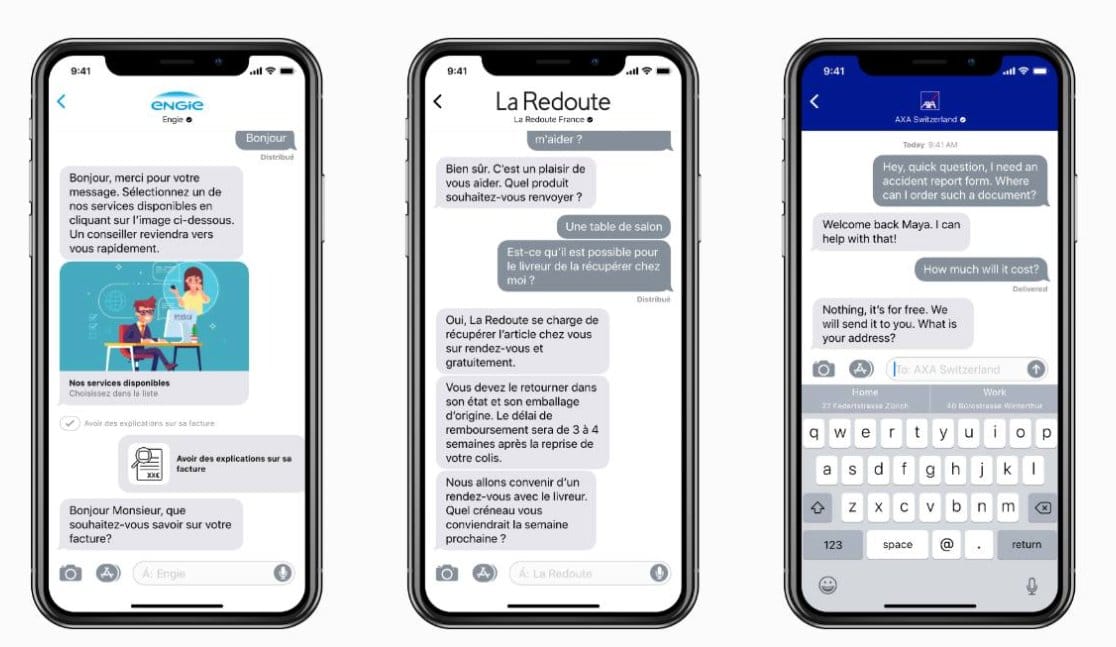Messaging is experiencing the strongest growth among means of communication these past years. Among the most popular messaging apps, Messenger and WhatsApp pool more than 2 billion users while younger generations are neglecting phone calls more and more. During the WWDC 2017 Conference, Apple announced its project of investing in customer relations, with Apple Business Chat. This functionality is integrated in the last iOs version and gradually implemented by businesses.
Messaging: the future of Customer Care
Messaging is one of users’ favorite communication modes and draws currently more than 3,6 billion individuals. Apps such as Messenger and WhatsApp are the most popular but others also exist Viber, WeChat, Line, etc. Each one of them present specificities that make them popular in certain markets.
The advantage of messaging is the fact it is asynchronous, allowing to exchange according to your own rhythm: users can chat in real time, or answer later depending on their availabilities. This advantage can also benefit customer-company interactions. Customers are used to using messaging for their private usage, and expect to be able to use it as well to contact companies: 56% of users now prefer to contact a customer service through messaging than by phone call. According to Gartner, in 2019, requests linked to customer relations will be more prevalent on messaging apps than on social media.
This growth of messaging and in general of digital channels encourages companies to develop an Omni-Digital approach. Customers naturally use the channel they prefer and expect to find the same levels of customer service whatever the channel they use. By centralizing the handling of their digital channels, RingCentral Engage helps companies answer these expectations. By officially partnering with Facebook, we have supported AXA on Messenger as soon as their APIs were available. Whatever the new channels available, we follow this method in order to lead businesses on the new contact points chosen by their customers.
Apple Business Chat’s functionalities
iMessage, pre installed in every iPhone, is one of the most popular applications. With 700 million iPhone users worldwide, iMessage has a considerable user database.
Apple announced several months ago that they would launch Business Chat allowing customers to interact with companies through the Messages App. This functionality has been integrated to the 11.3 iOs version and can be used on all Apple devices: iPhone, iPad, Mac, and Apple Watch.
By being integrated to Apple’s ecosystem, it means you could start Business Chat conversations from Safari, Maps, Search, and Siri.

Apple developed functionalities simplifying interactions between companies and their customers such as:
- A unit for managing appointments, with which you can suggest available time slots that the customer can choose.
- A unit to choose products within a list so that you can choose characteristics such as color
- Payment with Apple Pay to make transactions without leaving the app
- Exchange rich media (photos, documents, and other files) with customers
How is Apple Business Chat different than other channels?
Other messaging channels such as Messenger are already available to customer relations. Even though they seem similar at first glance, every one of them have their own specificities. Here are those pertaining Business Chat :
- Exclusive usage from Apple devices: just like iMessage, Apple Business Chat is only available to iOs users. Similarly iMessage cannot be used on Android whereas apps like Messenger and WhatsApp are available on both iOs and Android. For companies, this means Business Chat will only be used by Apple devices users. This will also encourage individuals who were not using other messaging apps to start resorting to messaging for their customer service needs.
- Easier subscription: Some messaging apps require to register and share personal information like name, address, email, phone number, etc. With the Messages app and Apple Business Chat there is no need to create an account since it is already configured with Apple ID.
- A strong emphasis on confidentiality: Apple gives significant importance to its users’ data confidentiality accross its multiple services. On iMessage, an end-to-end encryption system protects conversations. This way messages are scrambled when they travel through third-party apps using iMessage. Apple has a clear transparency policy and unlike other platforms, is selling devices instead of services. This limits the risks of seeing them resell data to third parties. In the wake of data confidentiality is becoming one of users main concern, Apple Business Chat is answering these security expectations users have when contacting companies.
- Enriched functionalities: like we mentioned, Apple integrates to Business Chat functionalities that make it easier for companies and customers to communicate. By using Apple Business Chat, companies will be able to offer an ideal customer experience: without leaving the iMessage app customers will be able to pay, choose an appointment time, send various attachments, etc.
What are the impacts on businesses?
Considering the popularity of iMessage, being able to communicate with its customers via Apple Business Chat is an excellent opportunity for companies. Adapting its customer care strategy to the market changes is a formidable way of meeting customers’ expectations and being competitive.
Thanks to the constant increase of channels, companies are given the opportunity to reinforce their interactions with customers, but this also means they need to stay up to date which can be a challenge. Handling messages coming from multiple channels requires an appropriate organization designed with this specific challenge in mind to be able to answer efficiently.
In 2016, AXA was able to position itself as a pioneer by adopting Messenger for Business. By regrouping digital channels processing into one platform target=”_blank”, AXA was able to easily integrate this new channel without needing to reorganize it customer service department or training agents to a new tool. Messages coming from Messenger are processed the same way as those coming from other channels (email, chat, social media, etc). Thanks to this method, AXA offered customers a means of communications they find easy to use and tailored to their expectations.
Since it was launched in 2016, an increasing number of businesses have adhered to Messenger and more than 2 billion messages linked to customer relations are exchanged each month on this channel. This result shows the relevance of using messaging for customer relations. In the same way as Apple with Business Chat, other GAFA channels will soon be launched: WhatsApp for Business, Amazon Anytime, Google Chat. These innovations will even more emphasize the role of messaging in customer care interactions.
Update October 2, 2018
Apple Business Chat is now available in Australia, Canada, France, Germany, Hong Kong, Italy, Japan, Singapore, Switzerland, UK and US. As an Apple Business Chat CSP (Customer Service Platform), RingCentral Engage allows you to adopt this channel and manage messages from the same platform as your other channels.ENGIE, AXA and La Redoute are our first clients adopting Apple Business Chat. To learn more, visit our dedicated page.

Originally published May 03, 2018, updated Dec 30, 2022





